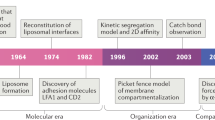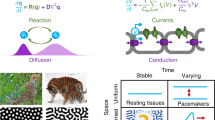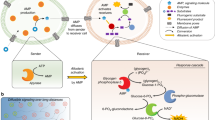Abstract
ALTHOUGH it is not possible at present to give a general definition of the cellular surface membrane, or even to define its spatial limits, the consensus now is that it is related to the structure which under the electron microscope appears as a three-layered complex, about 75 Å thick1. The physiologist generally assumes that this structure represents the barrier which he finds, by indirect means, restricting the flux of ions at the cell boundary. The general idea about this diffusion barrier is that its resistance is uniformly high over all faces of a given cell. This idea derives chiefly from electrophysiological work with a rather special group of cells which, like skeletal muscle and nerve fibres, have adapted to transmit electrical signals without appreciable cross-talk between cell neighbors; or which, like blood and gamete cells, are normally unconnected. Indeed, in these elements, except for special synaptic contact regions2–11 and certain neuroglia contacts12, the surface resistance is in general high and, within the limits of resolution of the methods, distributed rather uniformly over the cell surface.
This is a preview of subscription content, access via your institution
Access options
Subscribe to this journal
Receive 51 print issues and online access
$199.00 per year
only $3.90 per issue
Buy this article
- Purchase on Springer Link
- Instant access to full article PDF
Prices may be subject to local taxes which are calculated during checkout
Similar content being viewed by others
References
See Robertson, J. D., Biochem. Soc. Symp., 16, 1 (1959).
Bullock, T. H., J. Comp. Neurol., 98, 37 (1953).
Furshpan, E. J., and Potter, D. D., J. Physiol., 145, 289 (1959).
Hagiwara, S., Watanabe, A., and Saito, N., J. Neurophysiol., 22, 554 (1959).
Tauc, L., C. R. Acad. Sci., Paris, 248, 1857 (1959).
Watanabe, A., and Bullock, T. H., J. Gen. Physiol., 43, 1031 (1960).
Bennett, M. V. L., Fed. Proc., 19, 298 (1960).
Watanabe, A., and Grundfest, H., J. Gen. Physiol., 45, 267 (1961).
Wilson, D. M., Comp. Biochem. Physiol., 3, 274 (1961).
Hagiwara, S., and Morita, H., J. Neurophysiol., 25, 721 (1962).
Watanabe, A., and Takeda, K., J. Gen. Physiol., 46, 773 (1963).
Kuffler, S. W., and Potter, D. D. (personal communication).
Loewenstein, W. R., and Kanno, Y., J. Gen. Physiol., 46, 1123 (1963).
See Hodgkin, A. L., and Rushton, W. A. H., Proc. Roy. Soc., B, 133, 444 (1946).
Loewenstein, W. R., and Kanno, Y., J. Cell. Biol. (in the press).
Wiener, J., Spiro, D., and Loewenstein, W. R., J. Cell Biol. (in the press).
Compare with Farquhar, M. G., and Palade, G. E., J. Cell. Biol., 17, 375 (1963).
Author information
Authors and Affiliations
Rights and permissions
About this article
Cite this article
KANNO, Y., LOEWENSTEIN, W. Low-resistance Coupling between Gland Cells. Some Observations on Intercellular Contact Membranes and Intercellular Space. Nature 201, 194–195 (1964). https://doi.org/10.1038/201194a0
Issue Date:
DOI: https://doi.org/10.1038/201194a0
This article is cited by
-
Connexin26 Mutations Causing Palmoplantar Keratoderma and Deafness Interact with Connexin43, Modifying Gap Junction and Hemichannel Properties
Journal of Investigative Dermatology (2016)
-
Gap Junctions: Basic Structure and Function
Journal of Investigative Dermatology (2007)
-
Increasing Gap Junctional Coupling: A Tool for Dissecting the Role of Gap Junctions
Journal of Membrane Biology (2007)
-
Introduction: A Tribute to Cell-to-Cell Channels
Journal of Membrane Biology (2007)
-
Different localizations of 21 and 27 kDa gap-junction proteins in rat salivary glands
Histochemistry and Cell Biology (1995)
Comments
By submitting a comment you agree to abide by our Terms and Community Guidelines. If you find something abusive or that does not comply with our terms or guidelines please flag it as inappropriate.



